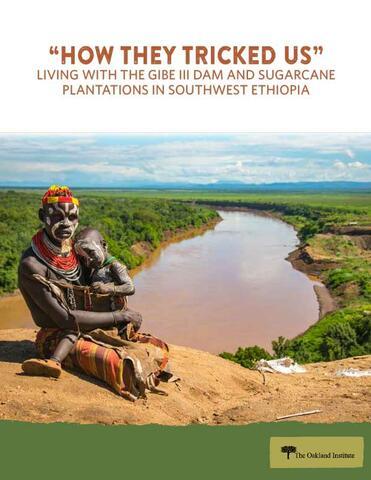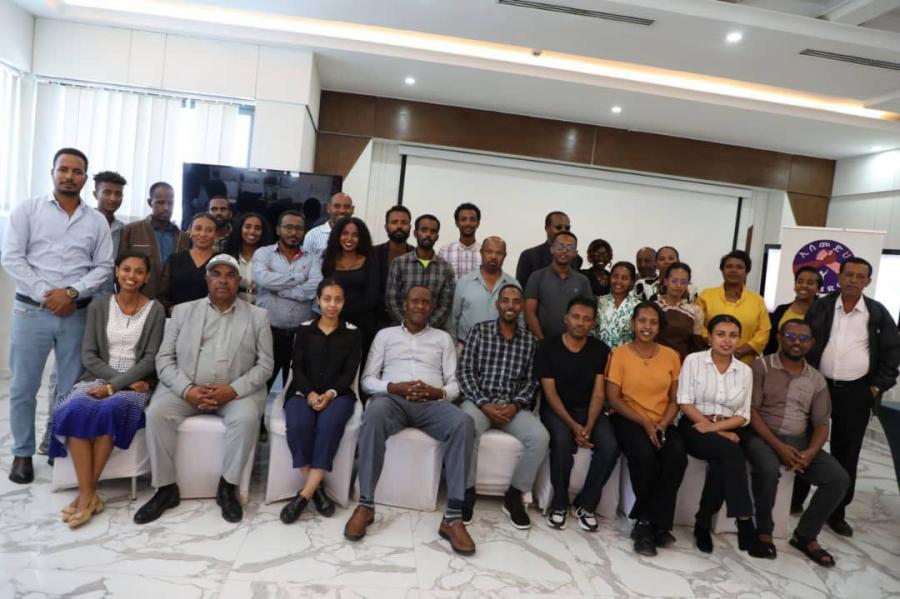
By Katherine Hamilton
A series of new development programs in Ethiopia’s Lower Omo Valley has resulted in disastrous consequences for local Indigenous communities, a new report from the Oakland Institute says. The report, “How They Tricked Us” includes findings from field research with the Mursi, Bodi, and Kwegu Peoples who are reeling from the impacts of the Gibe III Dam and Kuraz Sugarcane Development Project (KSDP). Government promises of compensation to Indigenous Peoples have been repeatedly broken, and resettlement and aid efforts deeply inadequate.
The Omo Valley of southern Ethiopia is home to over 12 Indigenous Tribes, eight of which rely significantly on the Omo River for livelihood, culture, and identity. The river and its floods allow for many of these groups’ traditional agriculture practices, as well as upkeep of cattle, which are an integral part of both survival and societal practices, like marriage and other ceremonies. Among the Omo Valley tribes are the Dassanech, Nyangatom, Murle, Kara, and Mugudji, but the report by the Oakland Institute focused mainly on the Bodi, Mursi, and Northern Kwegu Peoples, who they stated were hardest hit by recent development projects.
The Gibe III Dam and sugarcane plantations came about as part of a 1996 African Development Omo-Gibe Masterplan. Dam construction began in 2006 and land allocation for plantations occurred five years later. From the very start, major environmental concerns have been raised and human rights abuses reported, including forced evictions, crop destruction, and rape. Significant donors such as the World Bank, African Development Bank, and European Investment Bank originally refused to fund the dam due to its social and environmental violations. However, the World Bank eventually provided indirect financial support, along with funding from the China Development Bank and Ethiopian Sugar Corporation.
No environmental and social impact assessment was done for the Gibe III Dam and the assessment of the Kuraz sugarcane project took place after construction began and was never publicly released.
In the early days of planning for the Gibe Dam, the Ethiopian government made clear the many benefits it would have for local communities. They cited the massive 2006 flood as hugely devastating to regional populations of the area, but in reality, it yielded an unusually abundant harvest and may not have caused the chaos described by dam supporters. Flooding is a vital aspect to the agriculture and livelihood practices of the Mursi Peoples who reside around the Omo River, but with the Gibe III Dam, these floods seem to be permanently stopped. The report interviewed over 40 Mursi in the Omo Valley, and all of them reported that there had been no floods since the dam first started producing energy in 2015.
During construction, the Ethiopian government vowed to continue artificial floods in order to account for the needs of the Mursi Peoples. The dam construction company, Salini, incorporated a flood gate into the dam and promised to open it to create floods for ten days of the year. However, Salini later revealed in a statement that these artificial floods were to be temporary as a transition period for the Mursi to shift from traditional agriculture practices to more “modern” development. Additionally, a 2010 review of the dam noted that the controlled floods were unlikely to ever be released; a ten-day pause in electricity production would cause a revenue loss of 7-10 million USD and the flood would potentially damage irrigation infrastructure downstream.
Already, the lack of flooding has resulted in immediate and measurable harm to Mursi communities. According to the Institute, field research was done in an atmosphere of intense hunger among the Mursi, who are now sustaining themselves on the milk and blood from their cattle and the small amount of grain that can be exchanged for the cattle. Additionally, some Mursi have moved to the resettlement plots that were allotted, but the sites were too small to sufficiently feed a family. In one site, a family cultivated a maize crop, only to have it plowed over and replaced by a sugarcane plantation. Other promises of the resettlement sites, including schooling, health care, and food aid, have remained unfulfilled.
Reports from both the Mursi and the Bodi seem to show that the Ethiopian government is pressuring Indigenous Peoples to stop traditional cattle herding in order to transition toward modern development practices. Many people chose to leave resettlement sites because the government was threatening to seize or kill their cattle, according to one testimony. The Bodi are also told repeatedly that they can only have two head of cattle per household.
The Northern Kwegu have also been forced into resettlement sites due to loss of livelihoods. Almost all their territory has been overtaken for sugarcane plantations, but the massive job opportunities they were guaranteed have not materialized – only four percent of the predicted 700,000 jobs have actually employed Indigenous residents. Some Kwegu men have been employed by the government to hunt buffalo that eat sugarcane, but these jobs are temporary and low-paid, causing them to “live a precarious existence dependent on the whims of the government,” according to the Oakland Institute. The pressure to abandon traditional livelihoods has increased dependence in Indigenous communities that have long evaded state control.
The plantation jobs have also altered the demographics on the Omo Valley, as a majority of the employment is given to migrants from other parts of Ethiopia. The increased migrant population has increased HIV infections and alcohol accessibility in the region. Within communities, as well, there has been fracturing between those who support and benefit from the plantations and those who are against it. Recently, 13 died in a night shooting over disagreements about the sugarcane.
Along with local impacts, both projects have been economic failures. With most of the budget for the sugarcane plantations spent, the project is still only about halfway finished. The dam project has also gone over-budget, contributing to, rather than addressing, Ethiopia’s monumental foreign debt.
Currently, the Gibe IV and V Dam projects are underway, threatening to further harm Indigenous communities of the Omo Valley. The Institute’s report concludes by making a call for action and recognition from the Ethiopian government. The nation’s new Prime Minister, Abiy Ahmed has made promises to focus more on human rights and equity, and the report argues that this must focus particularly on the lower Omo region. Additionally, it is vital that the government acknowledges the failures of its development projects and acts to compensate for the harm it has already caused.

